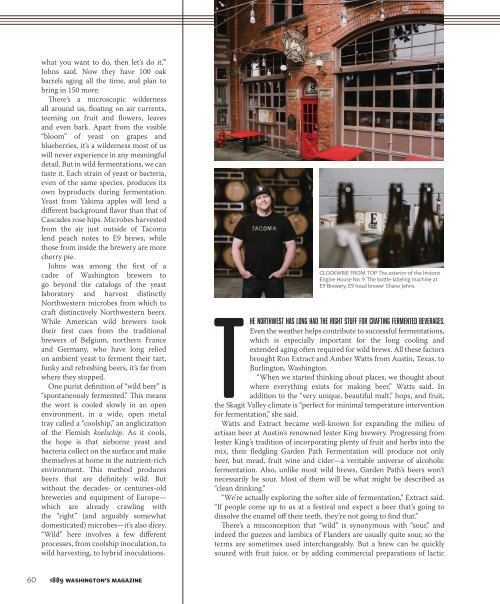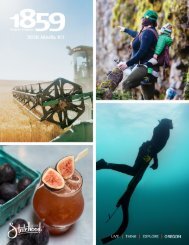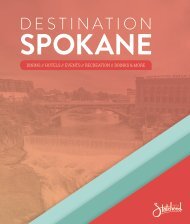1889 August | September 2018
You also want an ePaper? Increase the reach of your titles
YUMPU automatically turns print PDFs into web optimized ePapers that Google loves.
what you want to do, then let’s do it,’”<br />
Johns said. Now they have 100 oak<br />
barrels aging all the time, and plan to<br />
bring in 150 more.<br />
There’s a microscopic wilderness<br />
all around us, floating on air currents,<br />
teeming on fruit and flowers, leaves<br />
and even bark. Apart from the visible<br />
“bloom” of yeast on grapes and<br />
blueberries, it’s a wilderness most of us<br />
will never experience in any meaningful<br />
detail. But in wild fermentations, we can<br />
taste it. Each strain of yeast or bacteria,<br />
even of the same species, produces its<br />
own byproducts during fermentation.<br />
Yeast from Yakima apples will lend a<br />
different background flavor than that of<br />
Cascades rose hips. Microbes harvested<br />
from the air just outside of Tacoma<br />
lend peach notes to E9 brews, while<br />
those from inside the brewery are more<br />
cherry pie.<br />
Johns was among the first of a<br />
cadre of Washington brewers to<br />
go beyond the catalogs of the yeast<br />
laboratory and harvest distinctly<br />
Northwestern microbes from which to<br />
craft distinctively Northwestern beers.<br />
While American wild brewers took<br />
their first cues from the traditional<br />
brewers of Belgium, northern France<br />
and Germany, who have long relied<br />
on ambient yeast to ferment their tart,<br />
funky and refreshing beers, it’s far from<br />
where they stopped.<br />
One purist definition of “wild beer” is<br />
“spontaneously fermented.” This means<br />
the wort is cooled slowly in an open<br />
environment, in a wide, open metal<br />
tray called a “coolship,” an anglicization<br />
of the Flemish koelschip. As it cools,<br />
the hope is that airborne yeast and<br />
bacteria collect on the surface and make<br />
themselves at home in the nutrient-rich<br />
environment. This method produces<br />
beers that are definitely wild. But<br />
without the decades- or centuries-old<br />
breweries and equipment of Europe—<br />
which are already crawling with<br />
the “right” (and arguably somewhat<br />
domesticated) microbes—it’s also dicey.<br />
“Wild” here involves a few different<br />
processes, from coolship inoculation, to<br />
wild harvesting, to hybrid inoculations.<br />
CLOCKWISE FROM TOP The exterior of the historic<br />
Engine House No. 9. The bottle-labeling machine at<br />
E9 Brewery. E9 head brewer Shane Johns.<br />
The Northwest has long had the right stuff for crafting fermented beverages.<br />
Even the weather helps contribute to successful fermentations,<br />
which is especially important for the long cooling and<br />
extended aging often required for wild brews. All these factors<br />
brought Ron Extract and Amber Watts from Austin, Texas, to<br />
Burlington, Washington.<br />
“When we started thinking about places, we thought about<br />
where everything exists for making beer,” Watts said. In<br />
addition to the “very unique, beautiful malt,” hops, and fruit,<br />
the Skagit Valley climate is “perfect for minimal temperature intervention<br />
for fermentation,” she said.<br />
Watts and Extract became well-known for expanding the milieu of<br />
artisan beer at Austin’s renowned Jester King brewery. Progressing from<br />
Jester King’s tradition of incorporating plenty of fruit and herbs into the<br />
mix, their fledgling Garden Path Fermentation will produce not only<br />
beer, but mead, fruit wine and cider—a veritable universe of alcoholic<br />
fermentation. Also, unlike most wild brews, Garden Path’s beers won’t<br />
necessarily be sour. Most of them will be what might be described as<br />
“clean drinking.”<br />
“We’re actually exploring the softer side of fermentation,” Extract said.<br />
“If people come up to us at a festival and expect a beer that’s going to<br />
dissolve the enamel off their teeth, they’re not going to find that.”<br />
There’s a misconception that “wild” is synonymous with “sour,” and<br />
indeed the guezes and lambics of Flanders are usually quite sour, so the<br />
terms are sometimes used interchangeably. But a brew can be quickly<br />
soured with fruit juice, or by adding commercial preparations of lactic<br />
60 <strong>1889</strong> WASHINGTON’S MAGAZINE
















